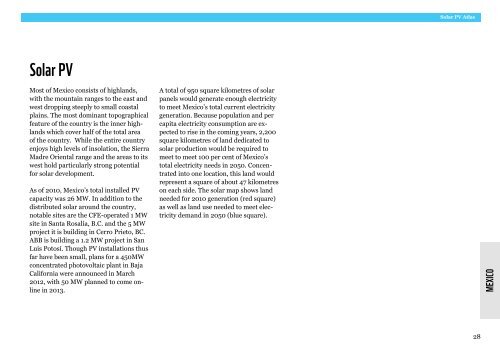Solar PV Atlas: Solar Power in Harmony with Nature - WWF
Solar PV Atlas: Solar Power in Harmony with Nature - WWF
Solar PV Atlas: Solar Power in Harmony with Nature - WWF
Create successful ePaper yourself
Turn your PDF publications into a flip-book with our unique Google optimized e-Paper software.
<strong>Solar</strong> <strong>PV</strong> <strong>Atlas</strong><br />
<strong>Solar</strong> <strong>PV</strong><br />
Most of Mexico consists of highlands,<br />
<strong>with</strong> the mounta<strong>in</strong> ranges to the east and<br />
west dropp<strong>in</strong>g steeply to small coastal<br />
pla<strong>in</strong>s. The most dom<strong>in</strong>ant topographical<br />
feature of the country is the <strong>in</strong>ner highlands<br />
which cover half of the total area<br />
of the country. While the entire country<br />
enjoys high levels of <strong>in</strong>solation, the Sierra<br />
Madre Oriental range and the areas to its<br />
west hold particularly strong potential<br />
for solar development.<br />
As of 2010, Mexico’s total <strong>in</strong>stalled <strong>PV</strong><br />
capacity was 26 MW. In addition to the<br />
distributed solar around the country,<br />
notable sites are the CFE-operated 1 MW<br />
site <strong>in</strong> Santa Rosalía, B.C. and the 5 MW<br />
project it is build<strong>in</strong>g <strong>in</strong> Cerro Prieto, BC.<br />
ABB is build<strong>in</strong>g a 1.2 MW project <strong>in</strong> San<br />
Luis Potosí. Though <strong>PV</strong> <strong>in</strong>stallations thus<br />
far have been small, plans for a 450MW<br />
concentrated photovoltaic plant <strong>in</strong> Baja<br />
California were announced <strong>in</strong> March<br />
2012, <strong>with</strong> 50 MW planned to come onl<strong>in</strong>e<br />
<strong>in</strong> 2013.<br />
A total of 950 square kilometres of solar<br />
panels would generate enough electricity<br />
to meet Mexico’s total current electricity<br />
generation. Because population and per<br />
capita electricity consumption are expected<br />
to rise <strong>in</strong> the com<strong>in</strong>g years, 2,200<br />
square kilometres of land dedicated to<br />
solar production would be required to<br />
meet to meet 100 per cent of Mexico’s<br />
total electricity needs <strong>in</strong> 2050. Concentrated<br />
<strong>in</strong>to one location, this land would<br />
represent a square of about 47 kilometres<br />
on each side. The solar map shows land<br />
needed for 2010 generation (red square)<br />
as well as land use needed to meet electricity<br />
demand <strong>in</strong> 2050 (blue square).<br />
MEXICO<br />
28

















